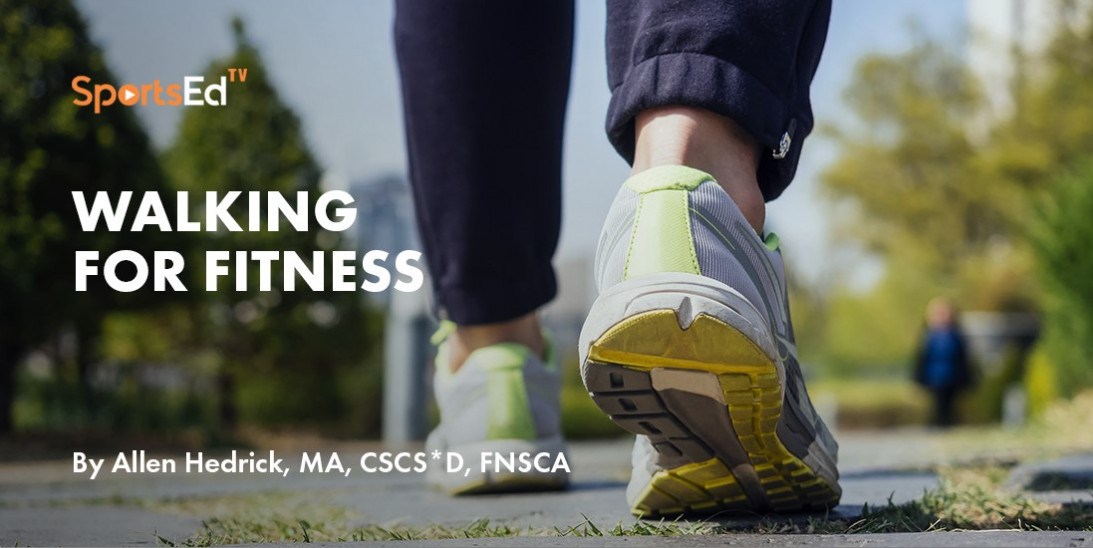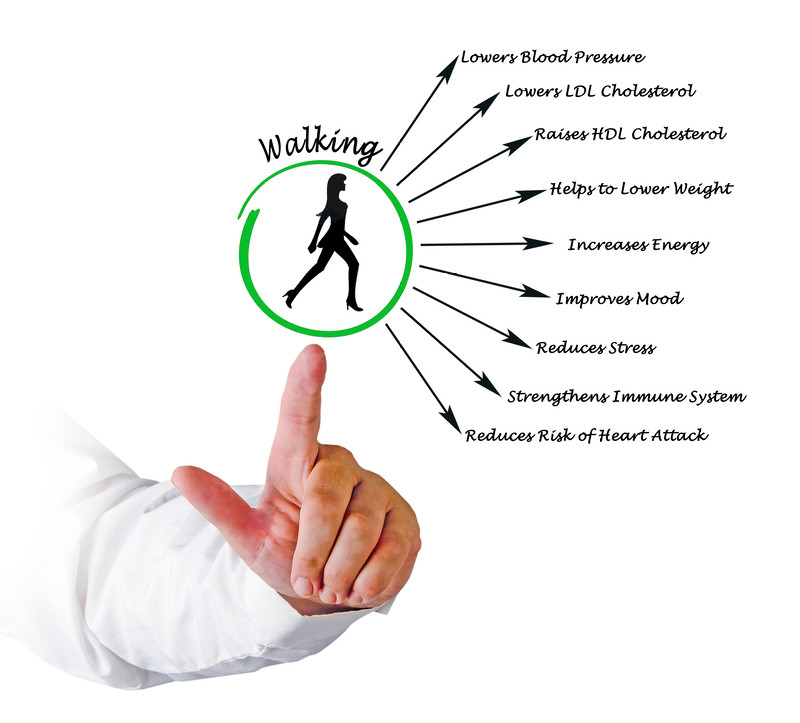Running
Welcome and thanks for visiting...

Summer Walking or Winter Walking For Fitness

Walking is recognized as a safe and effective mode of exercise when the goal is to improve fitness, health, or both. Something as simple as a daily brisk walk can help someone live a healthier life (2). One of the appeals of walking as a form of exercise is that it is accessible to anyone who is able-bodied, it requires little skill, and it has a low risk of injury. In addition, walking can be performed at a variety of speeds and intensities without the need for special equipment or clothing. Further, walking quickly is a moderate-intensity, low-impact workout that does not place excess forces on the joints (hip, knee, ankle) compared to what occurs with higher-intensity exercise (3).
However, like any form of exercise, in order to maximize the potential benefits, basic guidelines should be followed. The goal of this article is to educate the reader as to what those guidelines are so that the reader will be able to enhance the effectiveness of time spent training. Once the benefits of a walking program are provided, we will discuss how far, how fast, and how long the walk should be to best achieve these benefits.
Benefits of walking

Walking is exercise, and as a result, it causes an elevation in heart rate and increases one’s breathing rate and body temperature, resulting in sweat. Most people want to know what the benefits are before they elect to participate in an activity that causes those stressors on the body. The good news, as described by Thomas Frieden, former director of the Centers for Disease Control and Prevention, is that walking is the closest thing we have to a wonder drug (1). Presented here is a list of potential benefits you can experience as a result of participating in a walking program:
- Maintain a healthy weight and lose body fat (2, 4)
- Counteract the effects of weight-promoting genes (1)
- Help control a sweet tooth (1)
- The risk of breast cancer is reduced (1)
- It eases joint pain (1, 3)
- It boosts immune function (1,2)
- It can prevent or manage various conditions, including heart disease, stroke, high blood pressure, cancer, and type 2 diabetes (2, 3)
- Improves cardiovascular fitness (2, 4)
- Strengthens bones and muscles (2)
- Improve muscle endurance (2)
- Increase energy levels (2,3)
- Improve mood, cognition, memory, and sleep (2)
- Improve balance and coordination (2)
- Reduce stress and tension (2)
- Improve blood flow and can lower blood pressure (3)
Walking program
To best achieve this lengthy list of potential benefits, the walking program must be structured correctly. In simple terms, a walker needs to know how fast, how far, and how frequently they should walk for the best results. In general, the faster, farther, and more frequent the walk, the greater the benefits. However, you may start out below the standards provided and gradually increase how fast, how far, and how frequently you walk based on your current fitness level (2). A walker might start with five minutes a day the first week and then increase the time by five minutes each week until reaching at least 30 minutes per day (2). Taking this approach is a perfectly acceptable approach to begin a program.
How Fast should you walk?
The faster the walk, the greater the benefits. That’s the simple but accurate answer to how fast to walk. However, high speed does not need to be the initial approach. With progress, a walking speed that is less than maximal is still very beneficial. For example, you may start out walking at an average pace and then work up to walking faster. Walking a mile in a shorter amount of time is a great way to get aerobic activity, improve heart health, increase endurance, and burn calories (2)
A recent study using 60 men and 186 women with an average age of 63 provided insight into the effect of walking speed (6). Participants were divided into three groups: moderate intensity, high intensity, and no walking. Participants in the moderate-intensity continuous walking training group were instructed to walk at approximately 50% of their peak aerobic capacity for walking, using a pedometer to verify that they took 8,000 steps or more per day for four or more days per week.
In contrast, those in the high-intensity interval walking training group, monitored by accelerometry, were instructed to perform five or more sets of three-minute low-intensity walking at 40% of peak aerobic capacity, followed by a three-minute high-intensity walking above 70% of peak aerobic capacity for walking for four or more days per week. Isometric knee extension and flexion forces, peak aerobic capacity for cycling, and peak aerobic capacity for walking were all measured both before and after training (6).
In the high-intensity interval walking training group, peak aerobic capacity for walking increased by 9%, and isometric knee extension increased by 13%, both of which were significantly better than the results found in the moderate-intensity group. Further, the reduction in resting systolic blood pressure was higher for the high-intensity interval walking training group (6). Based on this, it is safe to say walking at a faster rate is more effective than walking at a slower pace, so a faster walking speed should be the goal over time.
Supporting this was information provided by the Harvard T.H. Chan School of Public Health, which stated that a growing body of evidence has shown that the faster the walking speed, the greater the health benefits. They defined a moderate speed of walking to be between 2.5 to 4.2 mph. A study found that those who walk regularly have a reduced risk of both cardiovascular disease (CVD) and early death from CVD compared to those who do not walk regularly. Important to note that while the greatest benefits occurred in those walking three mph or faster, those walking between 2.0 and 2.9 mph (considered a normal pace) saw a health benefit compared to those not walking regularly.
How far should you walk?

A popular suggestion is to aim to walk 10,000 steps a day. However, the goal of walking 10,000 steps is not actually based on science but was created as a marketing scheme by a company manufacturing pedometers (7). While research finds that more steps are better, a lower number of steps can improve health benefits. For example, a 10-year study involving 4,840 adults aged 40 and over found those who took at least 8,000 steps daily had a 51% lower death rate from all causes compared to those taking 4,000 steps daily or fewer (7).
A Women’s Health Study involving a group of 16,000 American women with an average age of 72 found that those taking 4,400 steps a day had a 41% lower death rate compared to those taking about 2,700 steps a day (7). Death rates continued to drop in relation to taking more steps, up to 7,500 per day. However, taking additional steps beyond 7,500 did not show additional benefits. While there is nothing wrong with aiming for 10,000 steps per day or even higher, there may not be additional health benefits for the additional steps (8).
As noted by the Center for Disease Control studies, the exact number of steps required to see a health benefit will vary among individuals (8). The general guideline from the Center for Disease Control and Prevention is to move more and sit less throughout the day, and that some physical activity is better than none.
How often should you walk?
Now that we have established how fast and how far aerobic training should be, we need to determine how frequently to participate in a walking program. The American Heart Association suggests that everyone reach a minimum of 30 minutes of some form of cardiovascular exercise five to seven days per week. A common guideline, and one suggested by the American Heart Association, is to complete at least 150 minutes of moderate-intensity aerobic activity or 75 minutes per week of vigorous aerobic activity, preferably spread over five to seven days each week. The time spent training can be broken into 10-minute sessions, if need be, rather than performing the entire duration at one time. It is estimated that only one in five adults and teens achieve that goal.
General walking guidelines
Now that how far, how fast, and how frequently you should walk have been discussed, some general guidelines for a safe and effective walking program can be presented. It is important to remember that it is okay to start slowly, especially if you have not been exercising regularly. For example, as mentioned previously, begin with five minutes a day for the first week and then increase the time by five minutes each week until it reaches at least 30 minutes (2). The ultimate goal is to aim for at least 60 minutes of physical activity a day. Breaking that up into several short sessions of activity throughout the day is an approach that can be taken. Any amount of activity is better than none at all. Small amounts of physical activity are helpful, and accumulated activity throughout the day adds up to provide health benefits.
Be sure to choose good walking shoes with proper arch support, a firm heel, and thick flexible soles to cushion the feet and absorb shock (2). Wear clothing that is loose and comfortable, appropriate for various types of weather, including layers in cooler weather. Wearing moisture-wicking fabrics may keep you more comfortable. If walking outdoors after dark, wear bright colors or reflective tape for visibility. When walking outdoors during the day apply sunscreen, and wear a hat and sunglasses. Some people elect to wear an activity tracker, app, or pedometer that can provide useful feedback regarding time, distance, heart rate, and caloric expenditure while at the same time being motivational (2).
When walking outdoors, be sure to choose the course carefully. Avoid paths with cracked sidewalks, potholes, low-hanging limbs, uneven turf, or other trip hazards. Remember to walk slowly for the first five to 10 minutes to warm up the muscles and prepare the body for more strenuous exercise to follow. When finished with the walk, walk slowly for five to 10 minutes to help the muscles cool down (2).
Exercise motivation
Sometimes, one of the hardest things to accomplish after starting any exercise program is to stay committed to training. Starting a walking program takes the initiative. Sticking with it takes commitment. To stay motivated, adhere to the following suggestions (2):
- Start with simple goals, such as taking a short walk on your lunch break or after work, and then gradually increase from there
- Walk at a specific time each day
- Do a dog walk
- Find ways to make the walk as enjoyable as possible. Ask your significant other, a friend, or a neighbor to walk with you. Joining a walking group can be beneficial and helps hold you accountable.
- Listening to music while walking can be quite helpful
- Vary where you walk, using several different routes
- Find a new neighborhood or park to walk in
- As fitness improves, find routes that include hills or stairs
- Integrate interval training into your walking by alternating walking faster for a few minutes and then slowing down for a few minutes, then repeating the cycle
- Let people know where you are walking and walk in well-lighted, safe locations
- If you miss a day, don’t stress about it
- If you start skipping your walking days, don’t give up, just get back on track
Summary
Based on the information provided, walking can be a safe and effective method to both enhance fitness and health. However, to maximize time and effort, the guidelines provided on how fast, how far, and how frequent walking should occur must be adhered to. Depending on one’s current fitness level, those standards may currently be out of reach, but over time, as fitness improves, reaching those standards are your goals.
References
- 5 Surprising Benefits of Walking, August 25, 2022, Harvard Health
- Walking: Trim Your Waistline, Improve Your Health, Mayo Clinic Staff, May 19, 2021
- Walking for Exercise, Harvard T.H. Chan School of Public Health, September 2022
- The Effect of Walking on Fitness, Fatness and Resting Blood Pressure: A Meta-Analysis of Randomized, Controlled Trials, Preventive Medicine, 44(5):377-385, 2007
- Women Walking for Health and Fitness: How Much is Enough? Journal of American Medical Association, 266(23), 1991
- Effects of High-Intensity Interval Walking Training on Physical Fitness and Blood Pressure in Middle-Aged and Older People, Mayo Clinic, July 2007, 82(7):803-811
- 10,000 Steps a Day-or Fewer, Harvard Health Publishing, July 11, 2019
- Physical Activity, World Health Organization, October 5, 2022








